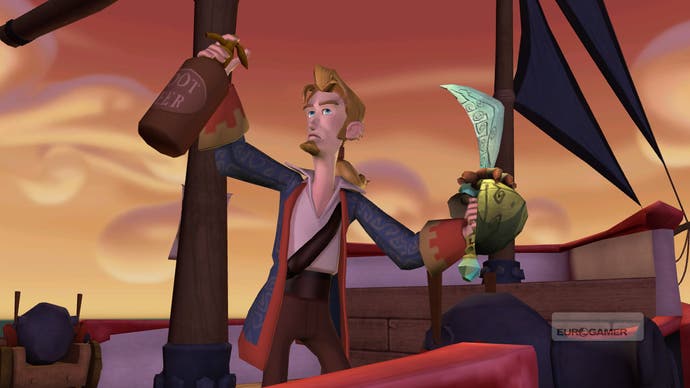Tales of Monkey Island: Launch of the Screaming Narwhal
Tales of the expected.
Most of the game's many puzzles present themselves as good old-fashioned object-manipulation, either finding an unexpected use for an otherwise innocuous item, or fashioning an entirely new one out of two unrelated ones. You know the drill (or rather monkey wrench). Happily, Telltale has also gone beyond the adventure game template on a number of occasions, notably on the map-based puzzles where the solutions are especially gratifying once the penny drops, and on a set-piece where Guybrush finds himself strapped to a doctor's chair. Sometimes, of course, you'll hit a brick wall, but the game's subtle built-in hint system (which you can turn off altogether if you prefer) does a decent job of guiding the way without ruining it for you.
Another area that Telltale succeeds in is the writing department. The story is, as you'd hope, classic Monkey Island nonsense, and it's impossible to overstate how instrumental Dominic Armato's performance as Guybrush is in getting the 'feel' just right. At its best, the script is generally sharp and witty, with some fantastic one-liners and moments of cackling silliness complemented by knowing nods to the past. For the most part, the fan service is excellent.
On the downside, Tales of Monkey Island suffers from the same syndrome which afflicted Telltale's Sam & Max games, where the lead characters were excellent, and had uniformly top-notch lines, while the supporting cast were a little forgettable, and sometimes just not that funny. For whatever reason, some if not most of the supporting cast of Tales of Monkey Island are hackneyed regional stereotypes: the eccentric Frenchman, the gruff Irishman, and so on. Next to the wry delivery of Guybrush, many of these characters feel somewhat two-dimensional, and it detracts somewhat from the overall quality.
Worse still, the visual representation of some of these characters feels like it was rushed, with at least three of the supporting cast based on the same basic character model. The graphical style, too, is an uneven mixture of excellent and extremely average. Sometimes, the environments feel elaborate and intricate, and other times comparatively bland - a factor not helped in the least, you feel, by an ageing 3D engine and an occasional lack of artistic inspiration.

On the one hand, characters like Guybrush are superbly rendered, and wonderfully animated, and on the other, there are a host of completely anonymous supporting characters. It really does feel like a game that could have benefited from a few extra months of polish, and would have been improved no end if more love had been lavished on the supporting cast. Sad to say, but it feels like Telltale simply ran out of time and money and had to make do.
Not wishing to end the review on a downer, Telltale has at least learned one major lesson from its previous attempts at reinventing a LucasArts franchise: increasing the number of locations, and, in turn, making it feel much like the first part of a four-to-five-hour mini-adventure, rather than merely a standalone episode. Word is that future episodes of Tales of Monkey Island will avoid the rampant recycling that was present in previous Telltale adventures, so there's every reason to be excited by what's to come over the next four months.
Although it's not quite everything it could have been, Tales of Monkey Island marks a highly entertaining return to a much-loved series. Despite a rather forgettable supporting cast, Telltale makes up for it with consistently excellent puzzle design, and occasional flourishes of comedy genius. Adventure game fans might pull a face about one or two things that Telltale dropped the ball on, but overall no one can deny that it's great to have the series back.

